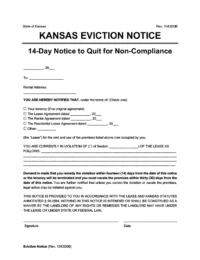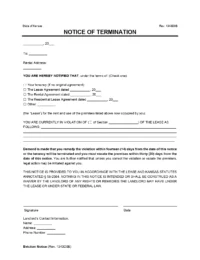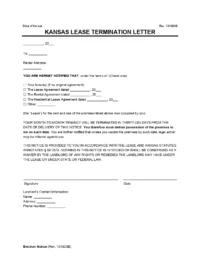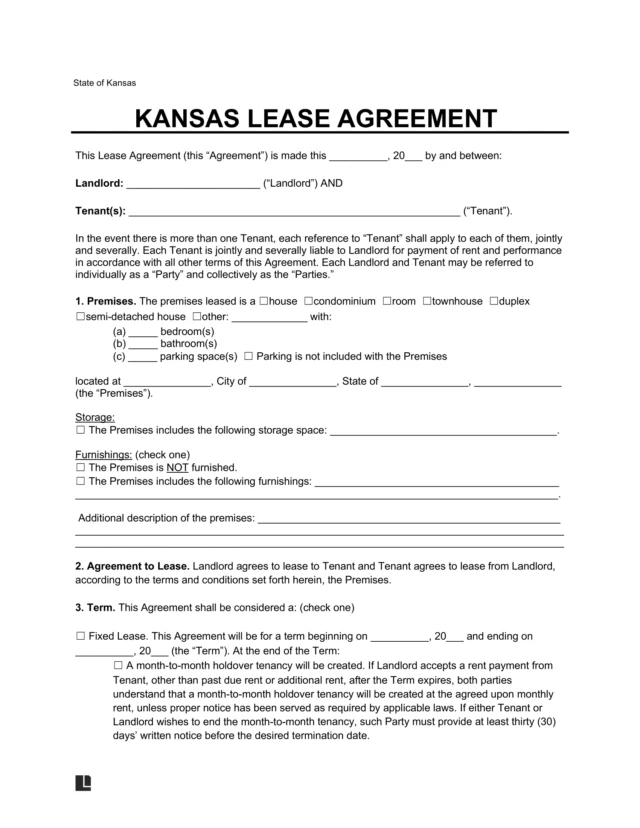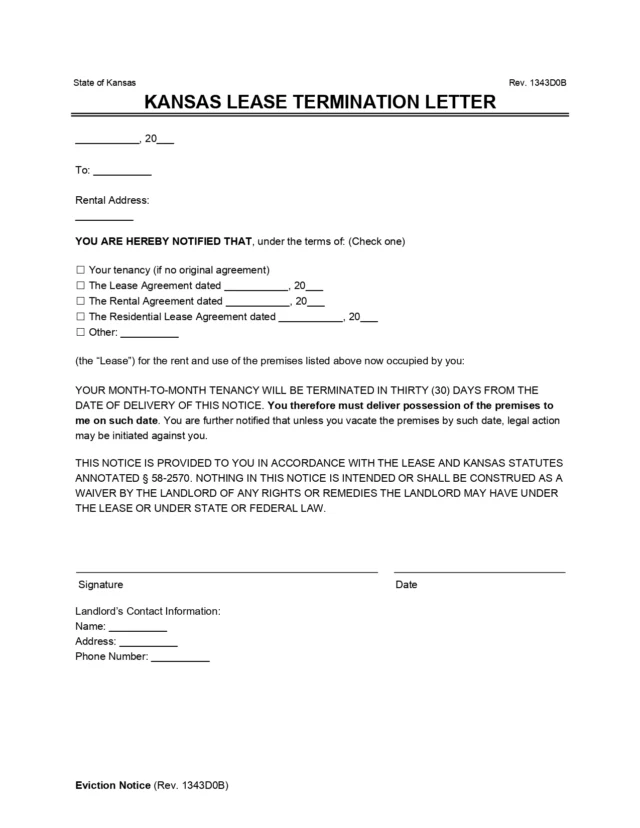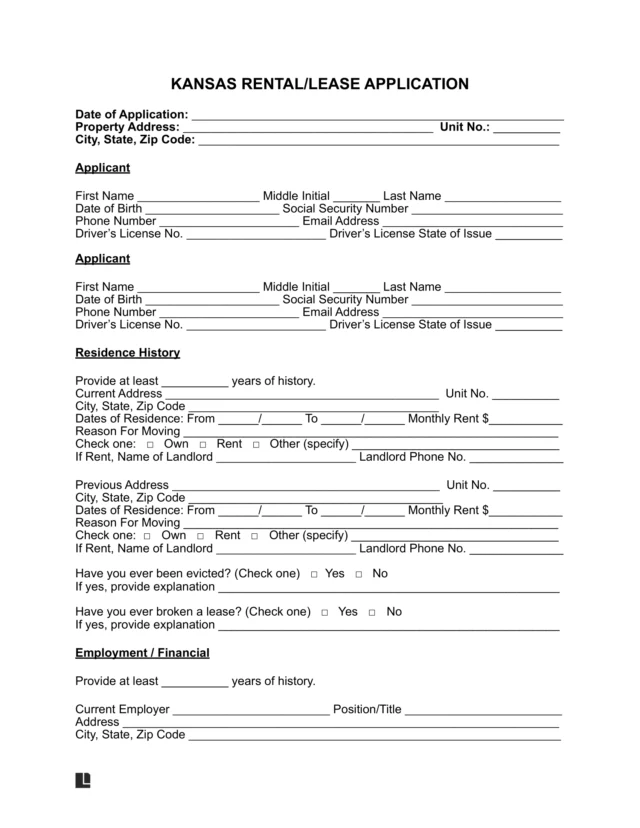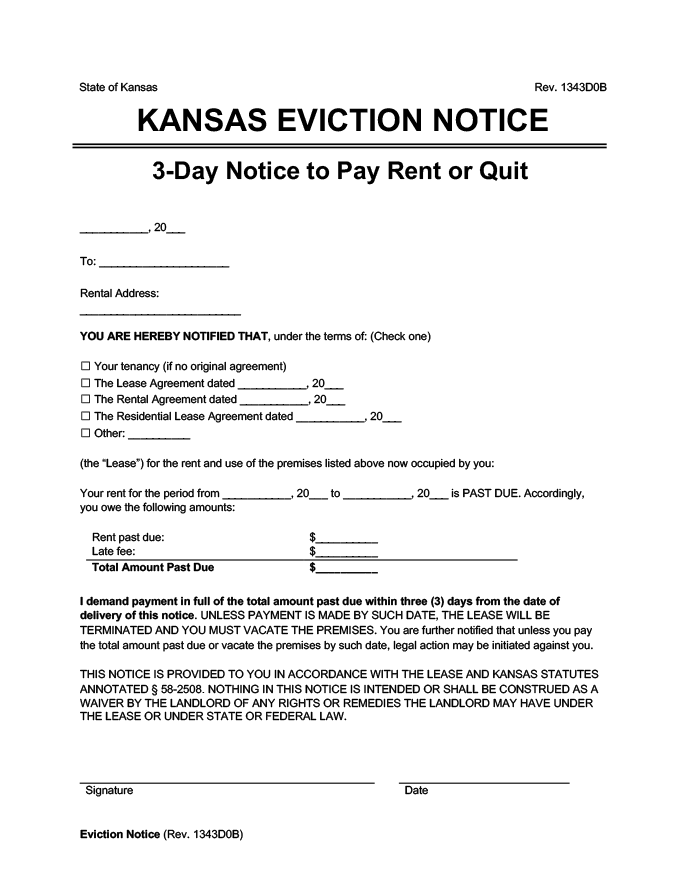Understanding Eviction Notices in Kansas
Before starting a formal eviction case in Kansas, landlords must serve tenants with a written eviction notice that follows Chapter 58 of the Kansas Statutes. This notice must clearly explain the reason for eviction and give the legally required amount of time to fix the issue or move out.
Kansas law requires 3- or 10-day notices for unpaid rent (depending on lease length), 14- or 30-day notices for lease violations, and 30-day notices to end month-to-month leases. Proper delivery of this notice is the first legal step in regaining possession of the property.
Legal Templates’ document builder makes it easy to create compliant Kansas eviction notices in minutes. Fill out the form to meet your needs and then download in PDF or Word format.
Types of Eviction Notices in Kansas
Kansas landlords must select the right notice based on the reason for eviction and the length of the lease. Legal timelines vary from three days to 30 days, and notices must be served correctly for an eviction case to move forward.
3-Day Notice to Pay Rent or Quit
Landlords may issue a 3-day notice to pay or quit under KS Stat § 58-2508 for tenants who have lived in the property for less than three months. This gives tenants three days to pay overdue rent or face eviction.
3-Day Notice to Quit for Non-Payment
Landlords must give tenants with a tenancy of three months or shorter at least three days to pay their rent before the eviction process can proceed in court.
10-Day Notice to Pay Rent or Quit
For tenants who have lived in the unit for more than 3 months, landlords must issue a 10-day notice under KS Stat § 58-2507. If the tenant does not pay rent within 10 days, the landlord can proceed with court eviction.
10-Day Notice to Quit for Non-Payment
Landlords must give tenants with a tenancy of longer than three months at least ten days to pay their rent before the eviction process can proceed in court.
14-Day Notice to Comply or Vacate (First Lease Violation)
Kansas law (KS Stat § 58-2564(a)) requires landlords to issue a 14-day notice for a first lease violation, such as property damage or unauthorized occupants. If the tenant fails to correct the issue within 14 days, they must vacate the property within 30 days of receiving the notice.
14-Day Notice to Quit for Non-Compliance
Use this notice for lease violations, allowing remedy or requiring 30-day vacancy, with no retention option for repeat offenses.
30-Day Notice to Quit for Repeat Violations
If a tenant commits the same or a similar violation within six months of receiving a 14-day notice, the landlord may issue a 30-day notice to quit without giving the tenant the opportunity to remedy the issue.
30-Day Notice to Quit for Non-Compliance
Use this notice for a tenant's second similar breach following a prior 14-day notice, mandating vacating with no remedy option.
30-Day Lease Termination Notice (Month-to-Month Tenancy)
To end a month-to-month lease, Kansas landlords must give 30 days’ written notice under KS Stat § 58-2570. This termination does not require a lease violation and may be delivered at any time.
30-Day Lease Termination
Use this notice to let a tenant know that you’re ending a month-to-month lease agreement and that they must prepare to leave your property in 30 days.
How to Evict a Tenant in Kansas
KS Stat Ch. 58 governs eviction cases in Kansas. Here’s how the process works:
Step 1 – Serve Notice
The landlord must first serve the tenant with a written notice to quit the property to start the eviction process (by first-class mail, certified mail, another mailing service (preferably with return receipt), or personal services like hand delivery or messenger with the posting of the notice on the front door).
In the notice, they must state the reason(s) for eviction, such as:
- Not paying rent when rent is due.
- Violating the rental agreement.
- Terminating a month-to-month tenancy.
The length of time required in the notice will depend on the reason for eviction, but will be at least three (3) days.
Step 2 – File Eviction Lawsuit
If a tenant has not responded, meaning they haven’t paid the overdue rent or moved out within the specified time after receiving a notice, the landlord has the right to file a summons and eviction petition with the district court in the county where the property is located.
It’s important to note that there may be a filing fee or other court costs associated with initiating an eviction lawsuit.
Step 3 – Schedule Hearing Date
The court sets a hearing date of 3 to 14 days from the issuance of the summons and petition. Both the summons and petition must be served on the tenant.
Step 4- Tenant Answers or Defaults
If the tenant wants to contest the eviction, they must file a written answer to the summons and petition within the time frame indicated on the summons.
If the tenant fails to appear at the hearing, the court may enter a default judgment (per KS Stat. § 61-3301) in favor of the landlord and a writ of restitution and execution to regain possession of the property.
Step 5 – Court Sets Trial Date
If the tenant files an answer to the complaint and the court needs more information, a trial date is set for 14 days after the answer has been filed.
Step 6 – Landlord Wins Judgment
If the landlord wins, judgment is entered, and the landlord can request a Writ of Restitution to remove the tenant from the premises. A marshal, sheriff’s deputy, or other law enforcement officer serves the execution order on the tenant.
The tenant then has twenty-four hours to leave the premises.
Step 7 – Stay of Execution
The tenant has five days after the judgment to file an appeal. If the tenant files an appeal, they may apply for a stay of execution, which means the landlord cannot evict them until after the appeal process is complete.
Related Kansas Court Forms
- Eviction Summons: Served with the complaint to notify the tenant they’re being sued for eviction, the date and time, and location of the hearing, as well as what they must do.
- Answer to Petition for Eviction: The tenant answers the eviction lawsuit with this document and can allege any affirmative defenses, such as uninhabitable premises or full payment of rent.
- Writ of Restitution for Immediate Possession: The judge issues this court order after judgment is entered for the landlord. It’s used to remove the tenant from the rental premises.



